-
Ida Booker
Mrs Ida Booker, 47 Meadow Bank Avenue
This account was provided by Mrs Booker on 13th July 1996, when she was in her 91st year. The picture below shows Ida in the centre of the 1996 Avenue Centenary party. (Wearing a yellow blouse, behind the seated children).
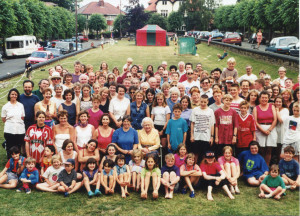
Ida lived in Nether Edge nearly all her life. In 1905 her parents had moved into Leyland Cottage, a newly-built house on Edgebrook Road. The house was quite large with good sized living rooms, five bedrooms (including the attics), a conservatory leading off the dining room and a number of cellars. It was fitted with both gas and electric lighting. Her Father had insisted on this because electricity was new and he didn’t trust its reliability. She remembers that as a child she used to find pieces of mother of pearl in the garden and it may be that there had once been a small workshop on the site, making buttons or pearl handles for the cutlery trade.
Edgebrook Road had a barrier close to Leyland Cottage, where the road still narrows and Mrs Booker remembers gates at the end of Ladysmith Avenue. These had to be closed at intervals to maintain the road’s private status. The Ladysmith gates were just in front of the first house on the left hand side and, like Meadow Bank Avenue, the road was planted with lime trees. (Editor’s note; This information is particularly interesting because Ladysmith/Edgebrook was another of Elizabeth Newbould’s developments. The houses were more modest than those of Meadow Bank Avenue but the stipulations were the same).
On Ladysmith Avenue there still stands a fine red brick building ‘The Edge’. Mrs Booker remembers that this used to be a nursery school at the beginning of the twentieth century and her brother went there for a while. Lyndhurst Road had not been developed at that stage but the land was used for allotments during the First World War. There were one or two houses, more especially at the top of Lyndhurst Road. One of these belonged to the Flathers family.
Mrs Booker’s Father travelled into town every day to his work as Manager of The Public Benefit Boot Company. The shop was at Moorhead, just behind the monument that was erected to commemorate the Crimean War. The monument was later dismantled and the statue of Queen Victoria is now in the Botanical Gardens. After a while her Father set up his own shop in Firth Park and was a wholesale dealer in boots and shoes. The family moved to Firth Park at this stage but Ida was keen to move back to Nether Edge, which she did after her marriage.
As a young girl, Ida went to Abbeydale School, where infants, juniors and seniors all shared the same site. Infants and senior girls used the left side of the building, juniors and seniors boys the right. Her two sisters also went to the School and one of them was in the same class as Renee Richardson (later Robinson), a neighbour of Ida’s on the Avenue for many years until her death in 1989. Renee had told Ida that one of her Grandfathers had been a stonemason who had worked on the construction of the Avenue walls around the Green. The unreliable nature of his work had led him to give it up and he had become Master of the Workhouse on Union Road. Another Avenue resident, Miss Hamer was also a contemporary from school days, although they were not close friends as schoolgirls.
Ida remembers coming onto the Avenue to play. This was not really permitted, since the private road signs were clearly displayed, and children could expect to be turned away. They hardly dared to come down and always felt they were sneaking in. She did, however, have an explanation ready in case she was challenged. Her sister was sometimes asked to take a message from Miss Sanderson, a teacher at Abbeydale, to Miss Dixon, also a teacher, who lived on Edge Bank. The girls would say they were en route to Miss Dixon’s if anyone stopped them. (Note; a photograph of Miss Dixon is included in Bryan Ellis’s recollections)
Ida remembers a tennis court on the Green and playing games in the foundations of numbers 44-50. These had been dug at the time of the First World War but weren’t completed until much later. She was certain that these houses had originally had bricked cellar foundations but none of them were eventually completed with cellars.
At the age of twelve Ida passed the Scholarship Examination for the Central School in Leopold Street. The fees were two guineas a term for the first year and then it was free. She took the tram to school every day and remembers it being an excellent service with trams every five minutes. There were proposals to extend the tram from Nether Edge terminus to the Hospital but these were turned down.
The playing fields for the Central School were at High Storrs and every week the pupils would make the journey from town to Banner Cross on the tram for their games lesson. The fare was one halfpenny but the tram stopped at Banner Cross so the rest of the journey was on foot. Later a new school was built on part of the playing fields; this was the present High Storrs School.
After her first marriage, Mrs Booker lived on Brincliffe Edge Road, near the junction with Union Road. She had been very happy to return to Nether Edge but sadly had been widowed when her daughter was less than two years old. Whilst staying with her in-laws on Chelsea Road, soon after her bereavement, someone had attempted to burgle her house and soon after she decided to move to a smaller place. Eventually she found a place to rent on Osborne Road and she was living here during the Second World War.
Mrs Booker had very clear memories of the Sheffield Blitz. Fortunately she had been visiting her in-laws on Chelsea Road when the bombing started. She decided to stay with them and they went into the cellar’s reinforced shelter. One bomb made a crater in Chelsea Road and, when she returned to her own house on Osborne Road the next day, the roof had been blown off. Her brother was in the Home Guard and one of his group had a lorry, which they loaded up with her belongings. They were stored in her brother’s house at Whirlow for eight months, until she was able to return in August. Nether Edge suffered a lot from the bombing and the hospital was badly damaged. Mrs Booker believed that her Avenue home was used by the ARP wardens during the War and that they held meetings in the garage.
In 1949 Ida came to live at number 47 with her second husband. She had always liked the idea of living on the Avenue but few houses came up for sale. Number 47 had been built in the 1930s and in 1949 it was sold at auction. The Bookers had only seen it very briefly before the auction but it had been badly neglected and the cast iron bath was completely cracked. Ida remembers wondering how they were going to be able to replace it. They paid £2,025 for the house. The original owner, Mr Staniforth, had moved to number 45 and the occupants of 47 had been the Tranfields.
Ida always enjoyed living on the Avenue. People were quite reserved in the early days and there were fewer cars. She commented that visitors always expressed surprise when coming into the Avenue for the first time and she said, ’It’s a unique location, lovely for the children and relatively safe’. There had been many changes of ownership in the houses close to number 47, particularly at number 45. She remembered Mr Staniforth, the Thorntons, and Mary Stokes (of Stokes Tiles). Mary had lived there with her maid, Hester, who had to wear a formal maid’s uniform. Later the Seniors lived there and they built the detached house, number 15, for their daughter and her husband, Mr Kirkby. The Seniors were pawnbrokers and had several shops around the City. Eventually they had just one, opposite Banners department store in Attercliffe.
Other neighbours were also remembered. Miss Mavis Hamer’s family had originally lived on Machon Bank. She was a very studious young woman, not a mixer. She had become a teacher at Abbeydale and the family had a great love of music. Miss Hamer had at one time considered moving from number 39 to 45, which was much smaller, but had rejected it because it could not accommodate her grand piano. Her brother was an organist at Leicester Cathedral. Another Avenue resident, Cyril Cantrell (number 23), was also a very well-known music teacher and church organist at St Mark’s Broomhill. Miss Gwen Mousley (number 46) had been the accompanist to Eva Rich, a famous Sheffield singer in the 1930s and ‘40s.
The Ottoway family came to live on the Avenue and Ida remembered them from her Nether Edge childhood. At that time they had a plant nursery at the top of Oakdale Road and Mr Ottoway had given her tiny, sweet tomatoes from the greenhouse. Another Gardener, Mr Valle was remembered affectionately by Mrs Booker. As well as maintaining the Avenue and the Green, he had built her garden rockery and supplied many plants for the garden at number 47. (See chapter 3 of the Avenue Story for a photograph and more information about Mr Valle)
Mrs Booker spoke very fondly of her time on the Avenue. Her view of the Green meant that she could always see people passing and watch the children playing. She was saddened by the deaths of the Robinsons, Ted and Renee. Renee had died after suffering a stroke whilst shopping in the city centre. It was a shock at the time and a personal loss of a very old friend. There had been some obvious changes during almost half a century on the Avenue; far more cars, more ‘outsiders’ passing through and less respect for the private status of the road. She felt that some of the trees could be removed to give more light and she would like to see the copper beech trimmed into shape and its height reduced. However, the Avenue was still a lovely place to live and relatively safe compared to other neighbourhoods.
-
Derrick Cantrell
The Cantrell Family, 23 Meadow Bank Avenue.
These are the recollections of Mr Derrick Cantrell, son of Cyril and Winifred Cantrell.
(Notes from a telephone conversation with Hazel Hampton, 5.9.1996)
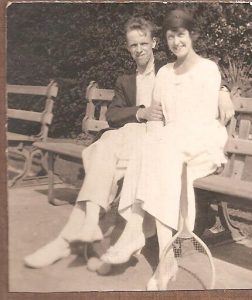
Cyril and Winifred Cantrell, parents of Derrick Cantrell
(possibly pictured at Brentwood Tennis Club)
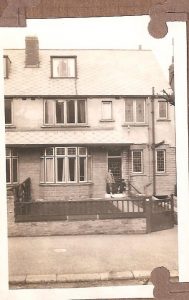
Number 23 with Winifred and Alan Cantrell in doorway, 1926 (provided by John Cantrell)
Mr Derrick Cantrell was born at 23 Meadow Bank Avenue in 1926. He left to join the armed forces in 1944. He believes that his parents moved into the Avenue a year before his birth. Before that they had lived in Havelock Square, Broomhall. He remembers the Avenue as ‘a wonderful place to grow up’ and, apart from the Blitz, has no negative memories of his time there.
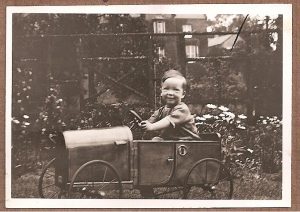
Derrick in the garden of number 23 in 1928
Derrick went to King Edward VII Grammar School and then to Keble College, Oxford. He was an organist at Chelmsford Cathedral (1953-62) and Manchester Cathedral (1962-77), and was appointed Professor at the Royal Northern College of Music in Manchester in 1963.
The Cantrells were a Sheffield family; Derrick’s Grandfather, Mr Edward Arthur Cantrell (b.1846) was in the cutlery trade and Derrick has cutlery bearing his company hallmark. Initially Edward Cantrell had his own firm but, when that failed, he worked for J.G. Greaves on St Mary’s Road.
Derrick Cantrell’s Father, Cyril was well-known in the City. He was a professional pianist, a Licentiate of the Royal Academy of Music (LRAM) and Associate of the Royal College of Music (ARCM), who gave lessons at Studio 34, Wilson Peck Limited. His pupils appeared regularly in the local paper with notifications of their examination and competition successes.
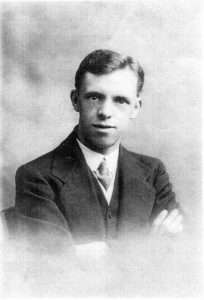
Cyril Cantrell
He was also an organist at St Mark’s Church, Broomhill. Cyril was the accompanyist for the Philharmonic Girls’ Choir and was involved in the Henry Wood concerts at the Victoria Hall in the City centre. His most famous pupil was Reginald Dixon; Cyril taught him to play the organ and Reg went on to entertain thousands of people at the Tower Ballroom in Blackpool, where he was resident organist from 1930-1970.
The Cantrell family at one time had a live-in, uniformed Maid called Mary. Derrick thinks this was only in the first few years of his life, perhaps until c1930. They also had a ‘Daily’ who came in to help on wash-days.
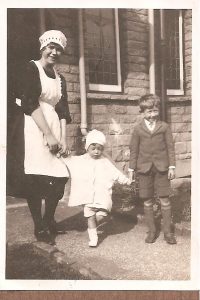
Photograph of the Cantrell family Maid with children, Derrick and Alan, circa 1930.
(Image kindly provided by Derrick’s son John Cantrell)
Remembering other Residents
Derrick Cantrell had a clear recall of Avenue residents. There wasn’t much socialising amongst residents but the population of the Avenue was very stable and everyone knew each other because they had lived together over a long period of time. The following residents were mentioned;
The Websters at 77 Cherry Tree Road (see Mr Webster’s recollections in ‘Lived Experience’ section)
Councillor Henry Kirk (3) lived just below the Websters;
Dr William Ripper, (43) who lived near ‘Ripper’s Field’ and was an engineer and Professor at Sheffield University (see Biographies section for a summary of Professor Ripper’s life);
Mr Jenkins, (41) He was another scientist and lived next door to Dr Ripper. He was much feared by the children; he hated cats and dogs and had animal traps in his garden. Mr Cantrell remembers him standing at his window taking pot shots at animals venturing into his garden. His car, one of the few on the Avenue, was always parked on the road and features in the postcard below, dating from the late 1920’s/early 30’s. Derrick thought the young boy in the picture might have been himself or his brother Alan.
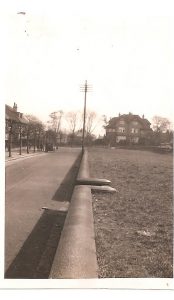
The road and car outside number 41. (supplied by John Cantrell)
Harry Heap (1901-1968) A ‘local celebrity’ and cartoonist for the local newspaper. He had once taken Derrick to a Yorkshire Cricket match. Charlie Kunz, a popular pianist who played dance band music, would stay with the Heaps when he was performing in Sheffield.
The Drabble sisters (36/38). Two of the sisters were recalled, (probably Antonia and Margaret) although they didn’t play with his generation. Mr Cantrell remembers them pretending to be horses and galloping up and down on the Green.
Mr and Mrs Meneer (25) The first Mrs Meneer was a singular lady who rarely went out and stayed confined in the house, although she was sometimes seen walking in the garden in beautiful Chinese silks, with her hair exquisitely done. Mr Percy Meneer, a Solicitor, used to go out shooting with his gun under his arm and wearing his breeches. He would often bring a brace of pheasants home for the Cantrell family. A car called at his house every day to take him to work or to shoot.
The Birch family (22) Mr Cantrell had memories of a ‘horrific accident’ befalling one of the older generation of the family. She had fallen into an open fire and suffered disfiguring burns.
Mrs Young who, Mr Cantrell thought, lived ‘two doors down’ from his family. He believed that she owned Meadow Bank House and intended to move into it, but it was destroyed in the Blitz. She later moved further up the Avenue on the same side.
Mr Stephenson, a famous Impresario, lived in what is now Tintagel House. Mr Cantrell understood that he had come up the hard way and made his money in coal mining. He was responsible for bringing all the big international opera singers to Sheffield to perform at the Lyceum. He had his name on all the concert programmes of the day. The visiting performers used to stay at his house and Mr Cantrell recalled hearing Mr Stephenson showing these guests around the gardens in a very fruity upper class voice. Mr Cantrell described Mr Stephenson as ‘one of the nouveau riche’.
Mrs Norah Swinscoe (30) was a professional golf champion and was ‘always in the news’. An annual ladies’ competition for the Norah Swinscoe golf trophy took place in Sheffield for many years.
Dr Webster lived in the detached house on the right hand side; he was a police doctor.
Mr Nell lived on the same side. He was a retired sea captain and kept a fierce bull terrier which was involved in several incidents in the Avenue. It would sometimes slip its leash and escape and maul the local animals. The children were very frightened of it.
Harrison Family (21) There were three Harrison children, Elsie, Stanley and possibly Ronald. Mr Harrison ran a shop selling secondhand goods. Stanley went to Jesus College, Oxford. The photograph below shows Stanley as a teenager
Editor’s note: An obituary for Stanley Harrison (1913-2000) in the Guardian, detailed his career in the intelligence service and his post-war activism in the CND and Communist movement in London.
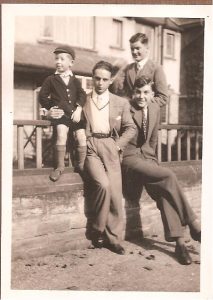
The young Derrick Cantrell on the left and Stanley Harrison seated on the wall right. c 1931.
Continuing down from his home at number 23 Mr Cantrell recalled
Henry Greaves and his family at number 29
The Seniors (31) There were two families of Seniors on the Avenue at this time. Mr Cantrell believed they were both in the same business as pawnbrokers.
The Sandersons Derek recalls that when the Sandersons moved this house was occupied by the local headquarters of the Moral Rearmament Group. He remembers people with flags and banners proclaiming their aims for peace.
Derrick’s Memories of an Avenue Childhood.
The development of the Avenue was incomplete during Derrick Cantrell’s childhood. He recalled three specific places which are now ‘closed’ to the Avenue children. The first of these was the open space beyond number 43, which he describes as a rough field that dropped away sharply to a jungle of trees at the bottom and ended in Montgomery Road. The children used to climb over a wire fence to gain access to this field. Secondly, there was the space where Harry Heap lived. He remembers these houses being built. Lastly, there was an area at the top of Edge Bank, where semi-detached houses (48-54) have been constructed.
The Tuck Shop
Derrick said, ‘this was a great facility for children which is no longer there’. This shop was 10 to 15 yards below Axe’s the decorator’s shop, which once stood at the corner of Cherry Tree and Machon Bank Road, opposite the Union Hotel. The tuck shop was kept by two old ladies. The Avenue children would often take a short cut through a friend’s garden on the right hand side of the road, hop over the wall and go to the tuck shop; getting back over the wall was more difficult! He remembers spending his halfpenny or penny on chocolate bars, liquorice shoe strings and gob stoppers.
Outside Play
Mr Cantrell remembers that, although there seemed to be little socialising between adults, the social life of the children on the Avenue was very rich. He recalls tree houses in the big trees at the top of the Green and games of cricket. He also remembers how the children used to play at sledging down the slope of the road leading into the Avenue (Kingfield) in winter, ‘much to the motorists’ disgust’.
Annual Rituals
He has no memory of an annual bonfire but he does remember the closure of the gates, ‘There were people manning the gates and it always seemed to be a memorable day’.
Memories of the War, 1939-45
Derrick Cantrell was 14 when War broke out. He described the Sheffield Blitz as ‘pretty awful’. The windows of his home (23) were blown out and, because the water supply was considered to be unsafe, families had to rely on water carts. There was no electricity and everything was terribly dirty. His Father, Cyril Cantrell, was organist at St Mark’s Broomhill at this time. It was a blow to him when the church went up in flames and he realised that his life would be greatly changed. For him as a young boy, however, it was also exciting. He remembers walking around the Avenue at 3 o’ clock in the morning and seeing a red glow in the sky over Sheffield as the burning city was reflected in the sky.
He also recalled that a bomb fell just 10 yards over the fence at the bottom of his garden into the garden of Meadow Bank House. On another night, an incendiary bomb set fire to Meadow Bank House; it was empty at the time. Mrs Young had been intending to move into the property. The Cantrell family were taking shelter in the reinforced cellar of Fred Marshall and his daughter, Dorothy, at number 19. They were very frightened and feared that the burning house would attract aircraft to drop more bombs. They would come up from the cellar every time there was a lull in the bombing to look at the house. It blazed all night.
-
Philip Marshall
-
Bryan Ellis
Bryan Ellis
Resident of 2 Edge Bank from 1939 to 2016
This account is based on a structured conversation between Bryan and Hazel Hampton on 17th June 1996. It is one of several interviews with early residents. The material was collected for the Avenue’s oral history archive as part of our 1996 Avenue Centenary celebrations.
Bryan has lived on Edge Bank since he was five years old. His family moved from the Middlewood area to Edge Bank in October 1939. They rented their cottage from Miss Dixon, who owned and lived in number 1 Edge Bank. Miss Dixon was a retired teacher who had taught Bryan’s mother and sisters at Sharrow Lane School. The family had always kept in touch with her and so, when 2 Edge Bank became vacant, Miss Dixon gave them first refusal.
Brian pictured with his mother
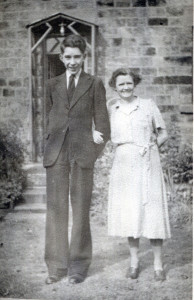
Early memories of Meadow Bank Avenue and Edge Bank
Bryan recalls that the majority of residents of Edge Bank were senior citizens. He was the only child on the Bank and consequently was spoilt. The residents were very protective towards him because he was a frail child.
Bryan understood that the newer houses opposite his family’s cottage , Nos. 6 and 7 Edge Bank, had been built in 1928. Miss Dixon believed that the land of numbers 6 and 7 belonged to her, and that she had been cheated out of it. She said that people from the cottages had always cultivated it. Her story was not supported by Mr Gilbey, who lived on Edge Bank from 1928, initially at number 6 and later in number 4, until his death at the age of 98. He said the land didn’t belong to her; it was unused land and people did cultivate it but common usage didn’t constitute ownership.
The Avenue was a lovely place to the young boy. Like most streets in Sheffield the Avenue was lit by gas lamps although the houses had been converted from gas lighting to electricity. The Green was so beautiful but ‘regrettably the Avenue children didn’t like outsiders to play on the Green and could be hostile’. Bryan’s best friend Paul Gadson lived at number 40. Paul moved onto the Avenue when he was seven years old, in 1941 or 42, and stayed for 21 years until his family emigrated to Australia .
People lived more private lives in those days. The men would go out to business each day, come home and didn’t appear to socialise with their neighbours as they do now. Children would play out on the Avenue. Bryan remembers his friend Paul out on his bicycle, but he was not allowed to play out on Sundays. This had nothing to do with religion but was a mark of respect for people’s privacy on their day off.
The Avenue was a very private road in those days. In 1939-45 few people would walk down the Avenue. At the top right hand side of the road lived a Mr Webster. If he was around he would stop anyone walking into the Avenue and challenge their reason for being there. Bryan observed, ‘If you stopped people like that these days you could end up in hospital, but in those days people had more respect for each other. You couldn’t do that today.’
Every year the gates at the top of the Avenue were closed and ropes were draped across the stumps at the bottom of Edge Bank. A notice reading ‘Road Closed’ was also erected. There used to be three stumps at the bottom of Edge Bank, although one was later taken out because women couldn’t get their prams through the space. On the middle stump, and at either end of the Green, there were notices which read; ‘These grounds are strictly private and are for the use of residents and their visitors only. The public must not trespass over them. By order of the Trustees’.
Bryan thinks he must have been seven or eight years old when he saw the railings burned off around the Avenue as part of the ‘War effort’. Railings could only be removed if it was safe to do so: that was not the case on Edge Bank and most of the original railings are still there. The irony of the wholesale removal of railings throughout the country was that the content of the metal was useless for recycling so the exercise was found to be pointless. The photo of Bryan’s mother below shows the railings still in place on Edge Bank at the end of the war.
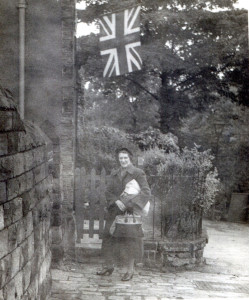
When Bryan was young there were only two or three Avenue families who had motor cars. The Birch family at number 22 had a car throughout the War. ‘The Avenue was not a car parking lot as it is now; children would walk to school or catch a bus.’
Most of the young Avenue children went to Abbeydale or Hunter’s Bar school. Bryan started off at Clifford Road School and then transferred to Hunter’s Bar. His friend Paul was taught at Hunter’s Bar by Mrs Edlington, who lived on the Avenue (No. 30) until her death in 1993. Paul passed the eleven plus and progressed to High Storrs School. The older children usually went to either the Girls’ High School or King Edward VII Grammar School for boys.
During Bryan’s childhood there were ‘live-in’ maids at numbers 49 and 51. They wore different uniforms for the mornings and afternoons; he recalls them answering the door wearing dark blue dresses and white aprons. He also saw a set of servants’ bells in the kitchen of his friend Paul’s house (No.40). Each bell was matched against each room of the house so the servant knew where she was required. He assumed that this relic meant that previous occupants must have had live-in maids. (Editor’s note; servants’ bells were a fairly common feature in the Victorian and Edwardian houses on the Avenue).
Bryan cannot recall a Christmas tree being erected on the Green when he was young but there was a bonfire on November 5th; nearly everyone turned out for it. He also remembers a tree house in one of the bigger trees, way up in the fork of two branches. Boys in their early teens had knocked nails into the trunk of the tree and climbed up that way. There was an entry through the floor of the tree house and Bryan seemed to think that they sometimes lit a little coal fire up in the tree house! Some of the children also held functions such as football matches, to raise money for the Red Cross during the War; Mrs Middlemass, who lived at number 26, used to do a lot of work for the Red Cross. Bryan was a member of the local Church Lads’ Brigade. The photograph below shows him on Edge Bank proudly wearing his uniform.
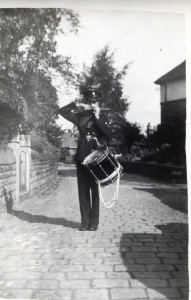
The Avenue and Edge Bank were maintained for a number of years by Mr Valle and his sons. (see Chapter 4 of the Avenue History) Mr Valle owned a horse, which he used to graze in the grounds of the Methodist Church on Psalter Lane. He would cut the grass on the Green just a few times each year and take it away in the cart. The Avenue children would sometimes gather up the long cut grass and pile it under one of the big trees. They would then climb the tree and jump down 10 or 12 feet into the heap.
The Impact of the Second World War 1939-45
Bryan had clear memories of the day that unexploded bombs fell on Violet Bank and Briar Roads. The residents of Edge Bank were considered to be at risk from the bombs and were evacuated to Carterknowle School. Avenue residents were not affected. When Mr Ellis (Bryan’s father) came home from work ‘he found we had flown and Edge Bank was cordoned off’. Evacuees lived in the classrooms and hall of the school, where there were also air raid shelters. The Ellis’s didn’t stay there long because Mr Moorhouse, who lived at 7 Edge Bank, invited them to live in the weekend retreat that he had built for himself near Holmesfield in Derbyshire. The Ellis’s and Miss Dixon went there for about ten days, staying until the emergency was over.
(Editor’s note; The intriguing story of Mr Moorhouse’s ‘bungalow’, which he constructed from old Sheffield trams, can be found in a separate interview with his daughter Mrs Evelyn Hodgson)
Bryan also recalled the Anderson shelters which some people had built deep into their gardens. Mr and Mrs Garwood, who lived at 5 Edge Bank, had a table shelter. It was erected on the wall, inside the back room of the cottage. ‘It looked like a large metal box and on the front of it was a wire screen – like the wire used to reinforce concrete. Both ends, the back and top of the box were made of steel and you could make a bed in it’.
One or two incendiary bombs fell on the dormer windows of houses on the Avenue. It was the practice on the Avenue to have a ladder placed in four strategic points around the Green wall. There were two at each end of the Green, one on either side. At the lower end of the Green they were sited across from numbers 43 and 52; at the top the ladders were opposite numbers 15 and 22. In front of each ladder was placed a contraption like a zinc bath on wheels. This could be pushed along to where it was needed; the water was then pumped out by stirrup pump. The residents responsible for the pumps had SP painted on their gates.
Most people used their cellars as air raid shelters. The cottages on Edge Bank had good cellars. Miss Dixon’s house (number 1) had three; one for coal, a second for food and the third for wine. Bryan’s family sheltered there on the night of the Sheffield Blitz;
‘I was down in Miss Dixon’s cellar that night. Miss Dixon used to sit in the passage with us and every time a bomb dropped she would put her arms up against the wall as though to hold it up. That night when I was brought up out of the cellar after the ‘all clear’ I remember looking through the gap into the garden of number 51 Meadow Bank Avenue and seeing a fiery red glow; the whole of the city centre was burning and in flames’.
Bryan also recalled the day a stick of incendiary bombs fell on Edge Bank. The bombs were like narrow grey cylinders, 6-7 inches long, and were supposed to flare when they hit the ground. The light from them provided the targets for the German bombers. Bryan’s father was in Mr Gilbey’s garden at the time. He grabbed a heavy stone urn full of earth and flowers and placed it over the incendiaries. The next evening, when the urn was to be restored to its place in the centre of the lawn, no one could lift it unaided. Fear had given Mr Ellis strength! The urn is shown in the photo below, next to the man in the dark suit.
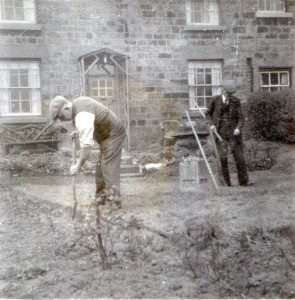
Bryan recalled a party on the lawn of number 4 Edge Bank on the evening of VE or VJ day 1945 at which food was served. He remembered his mother using powdered egg and shopping at the grocer’s where her rations book would be stamped. New books were obtained from the Ministry of Food on West Street. In this photograph of the party, Bryan is pictured in the foreground.
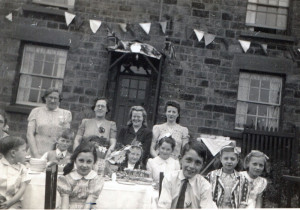
During the War children had to carry gasmasks in case of a gas attack. From time to time the masks had to be tested to make sure they were effective. Bryan remembers a vehicle being driven into the playground at Clifford Road School. The children had to put on their masks and enter the back of the van. If the masks were ill-fitting their eyes would immediately become red. The testing was made available to residents as well. Babies were provided with large crib-like protectors with a clear perspex viewer. There were underground shelters at the school; these were also used at night by local people.
Quite a few of the large houses on Chelsea Road were commandeered for military use. Brincliffe Towers at the top of Chelsea Park was occupied by the army; they laid out the asphalt paths in the park for the dispatch riders on their motorbikes. The trees around Lyndhurst Road provided excellent camouflage for army lorries. There was no anti-freeze then, so in winter their radiators had to be drained at night to prevent them from freezing up.
One of the air raid sirens for our area was located on Chelsea Road. It was placed on the roof of the first detached house on the left as one emerges from Cavendish Road. The local air raid wardens used to meet in the ‘ballroom’ over the garage of number 12 Meadow Bank Avenue, the home of the Truelove family.
Bryan’s memories of other Edge Bank residents
Miss Dixon of Number 1 Edge Bank
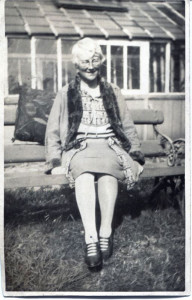
Miss Dixon, the owner of 1 Edge Bank, played an important part in Bryan’s life. Her family came from Belfast and her full name was Amelia Dorcas Dixon. She was an educated woman; an avid reader with a good library. She had been responsible for the Ellis’s move onto Edge Bank and the two households became very close friends.
Miss Dixon often wrote letters to the Avenue trustees, expressing her point of view firmly but politely. Bryan remembers her as a woman of strong opinions; ‘My father came from Londonderry and her family came from Belfast. He and she would argue over some subject and then she would put a letter through the letter box apologising’.
As well as being a schoolteacher she played a prominent part in the Girl Guides movement. She also had a sense of adventure – at the age of about forty she had travelled to Russia on a tramp steamer. This was in 1917, the year of the Bolshevik Revolution. In later life Miss Dixon was a creature of regular habit; every day apart from Saturday she would go to Davy’s restaurant for lunch and sit at a table in the window, overlooking Fargate.
She was very fond of young Bryan. He recalled that one day she had picked some plums in her garden and had left them in a saucer at the bottom of the tree. For some reason he crept round and ate them. She called round later in the day and said, ’a little bird came into my garden and stole my plums!’ He said that remark conveyed the quality of the relationship which existed between the two of them.
Unfortunately Bryan’s saddest memory concerns the manner of Miss Dixon’s death in 1953, when she was in her late ‘70s. ‘She died in her cottage next door and we didn’t even know she was in distress. It was such a waste’. The cause of her death was carbon monoxide poisoning from smoke inhalation. A faulty electric blanket had resulted in a smouldering fuse. There was no fire but the cottage had filled with toxic smoke. Miss Dixon was found on the bathroom floor by the laundry man who had called to collect her weekly box of linen. When he saw the smoke inside the house he went in and brought her out – but she could not be revived. The fire brigade came but the whole house was so badly damaged by smoke that all the beautiful things had to be destroyed.
After Miss Dixon’s death, No.1 Edge Bank and the old farm cottages (Nos. 2 and 3) came into the possession of Mr Wild. He paid £2,050 for the three properties and the whole site was freehold. Mr Wild was a safety officer, based in the Safety in Mines office on Broad Lane. When he had to move to the Buxton office he decided to break up the property and sell it to the sitting tenants. Mr and Mrs Ellis bought No.2 but Mr and Mrs Palethorpe at number 3 didn’t buy theirs. It was purchased as an investment by a lady who taught music at the Montessori School.
Mr Wild built the first garage on Edge Bank (c1960) and, with the permission of Mr Smith the Avenue Trustee, changed the stump which stood in the middle of the path outside Bryan’s house, from a fixed stump to a movable one. When Mr Wild sold the house it was bought by Dr and Mrs Murrell, he was a University academic and she worked at the cancer hospital on Tree Root Walk. The Murrells sold to Mr and Mrs Edwards and the movable stump continued to be a feature of Edge Bank until Mr Edwards became too frail to move it. When the lower part of Edge Bank was asphalted it never went back, but the stump may still be somewhere in the garden of No.1.
Bob Cundy, 5 Edge Bank
Bob was the landlord of The Union Hotel and he used to live at 5 Edge Bank. He bought the cottage from his landlady Mrs Glossop. When Bob had the Union there were two main rooms; it was not all opened up as it is now. Bryan remembers the beer barrels being delivered in an old steam waggon, which would chug up the hill to the pub emitting steam. The Union had not been Bob’s first pub, but before he became a publican he had worked for Tennant’s brewery as a singer and entertainer. If a pub wasn’t taking as much money as the brewery felt it should, Bob would be sent in to sing and entertain the customers.
Bob Cundy had told Bryan about the old Nether Edge Hospital’s days as a Workhouse and later a TB sanatorium. TB was rife in the 1940s; the sanatorium block was on the corner of the junction of Lyndhurst and Union roads. Bryan remembered the congregation from Sharrow Church Sunday School singing to the patients at Whitsuntide. He described the wards as really horrible, poorly lit and painted in miserable colours. Bob Cundy himself died of emphysema in 1990. He was in his eighties.
Tradespeople and Services
Milk delivery. For many years residents of the Avenue and Edge Bank had their milk delivered by Mr Ellison, whose milk came from the Chatsworth dairy on Junction Road (just above Hunter’s Bar School in the space now occupied by offices). He delivered the milk by pony and trap and carried the milk churn in his cart. He would fill a can and bring it to the door together with his measure. Customers would come to the door with jugs and he would measure out the required amount of milk.
Groceries. Tea was delivered by Wells Epsom, who had their depot on Gell Street behind the old Jessop’s Hospital. Orme’s also provided tea, other groceries and spirits to residents. They had a shop at the Nether Edge crossroads (currently the site of the Oxfam bookshop) and their vans made regular deliveries to the houses on the Avenue.
Meat. There were three butchers in Nether Edge. Tym’s (which used to be next to Turner’s bakery), Ecclesall Co-operative Butcher’s and Cheyney’s, a tiny shop on Byron Road.
Greengrocery. Mr Holmes was the greengrocer used by Mrs Ellis. He had a shop on Wolstenholme Road and after the War he delivered fruit and vegetables to the Avenue and Edge Bank every week. Newbould’s was another greengrocer’s and they also sold wet fish; their shop was where Pops supermarket now stands.
Plant and Garden produce. There were several market gardens in Nether Edge, including one on Byron Road owned by Mr Hinds and another opposite the King’s Centre on Union Road (formerly a Methodist Church). This belonged to Jack Swallow and his nursery had six or eight long greenhouses. They sold fresh garden produce and also plants, especially summer bedding plants. It was a thriving business and many local people went there to buy plants for their gardens.
Newspapers. Daily newspapers were sold at the Nether Edge bus stop by Mr Coffey, who lived on Sheldon Road. When all the business people had gone to work, he would walk up to the hospital and sell newspapers there. When he retired the paper round was bought by Steve’s father – and Steve in turn took on the business. He still runs the newsagent’s on Machon Bank Road.
Coal. There was no central heating in the houses during the early decades of Meadow Bank Avenue. Coal was delivered to the houses in a very old petrol-driven waggon. Miss Dixon ordered good quality coal for her kitchen fire from a Mr Stephenson. Mrs Ellis’s coal merchant was Mr Rose from Heeley. All the houses had coal fires and the ash in the dustbins was emptied at the door by a dustman carrying a huge two-handled pan. Bryan recalled the scene:
‘When they used to empty the dustbins they came round in a chain-driven vehicle sounding a klaxon horn. The vehicle had a big wooden type body with a lift-up lid on each side. A little ladder led up to the opening. The dustman would have a heavy leather pad on his shoulder. He would walk up the ladder carrying the huge pan on his shoulder. He then tilted his shoulder forwards, emptying the contents of the bin into the side of the truck. On windy days the ash would blow back into his face.’
Bryan’s deepest impressions of change 1939-96
‘I think the majority of people have lost a sense of pride in their environment , and that is the way most of Sheffield has gone. People won’t even go out and sweep the leaves from their paths, and it is so easy with the wheelie bins. I think generally people used to take more pride in the Avenue. Sheffield used to be a place of habit; people would feel they were letting the side down if there was litter blowing around in their area.
Perhaps it’s a bit more rowdy with the children but I’m perhaps being a bit unfair here. There are at least four times as many children than there used to be and at least they can play in safety.
I think when they had to introduce speed bumps that really showed how things had declined. There used to be an unspoken speed limit which people obeyed it was about 10mph or less. In those days common sense prevailed.
There was a greater awareness of the needs of other neighbours but I also believe that there is now a better mix of younger and older people who now blend together. If some things aren’t right, well you can never reach perfection’.
Reflecting specifically on Edge Bank, Bryan said, ‘It is only in the last 15 years (1981-96) that things have changed dramatically. Somehow, up to that point it used to hold together as a little community.’
Deepest impression of continuity
‘Whenever I come into the Avenue, especially with a visitor, and we walk the length of the Avenue and through into Edge Bank, people always remark that they feel that they are in the heart of the country. Some people, when they see the setts on Edge Bank, say they would like to see them covered with asphalt. If that happened it would stop being special and just become a driveway. I like to see the way the Avenue has matured and the care people take of the stone houses. It is an area that is really worth preserving’.

